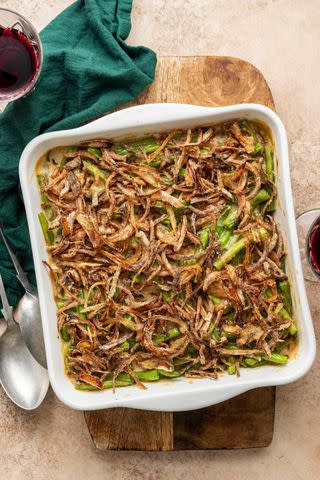The Magical Trick That Makes Green Bean Casserole Twice as Nice
You'd never guess what it is, but you'll taste the difference.
The original green bean casserole recipe, which is still beloved by millions on Thanksgiving, calls for canned green beans, condensed mushroom soup, black pepper, milk, soy sauce, and fried onions. It was the creation of Campbell’s Soup Company employee Dorcas Reilly in 1955, and it quickly became a holiday classic when the recipe was added to Campbell's Cream of Mushroom soup can label.
Despite it being such a popular Thanksgiving side, I can’t remember green bean casserole being served at any of my family gatherings. Perhaps it was because my mom preferred her green beans simmered with bacon.
This turned out to be a blessing in disguise because no one in the family held any nostalgia, fighting against me experimenting with my own green bean casserole recipe. And that is how I unexpectedly found an ingredient that instantly upgrades any green bean casserole recipe: miso.

Simply Recipes / Mihaela Kozaric Sebrek
Why Miso in Green Bean Casserole?
Miso is a fermented soybean paste. It’s not a traditional “casserole” ingredient, but maybe it should be. Because miso is fermented, it imparts a rich, savory flavor to a dish. It’s complex and packed with umami, adding a perfect touch of saltiness and sweetness. The idea isn't too far from the reason Ms. Reilly added soy sauce to the original recipe—it's also made with fermented soy and adds flavor in a way that using just salt can't.
There are different types of miso. For green bean casserole, I like to use white (or shiro) miso. It’s lighter and milder in flavor than the other varieties and pairs well with vegetables like green beans.
It's easy to find miso at any standard grocery store these days. I usually look in the international aisle or the refrigerated section, near the produce or tofu.
How To Add Miso To Your Green Bean Casserole
You can use your favorite green bean casserole recipe or experiment with something new as long as the ingredients remain somewhat neutral. If the recipe calls for strong-flavored ingredients like sun-dried tomatoes or olives, adding miso won't be a good choice because the flavors will collide. For all other recipes, you should be free to miso (it’s a verb now).
I recommend stirring in one tablespoon of white miso into the sauce—it's a paste, so you'll have to smoosh it in to fully dissolve. At this point, I give the sauce a taste and add more, a teaspoon at a time, until I get the umami I'm after. Then proceed with the recipe as written.
More Tips for Using Miso
You’ll end up buying more miso than you’ll need to make green bean casserole. Refrigerate leftovers in the original container, tightly covered. Though miso can last forever if stored correctly, I try to use it all within one year.
Luckily, miso is delicious in so many dishes beyond miso soup:
Use it to add depth to salad dressings and marinades
Add it to mushroom, French onion, and lentil soup for a bit of extra umami
Add it to your favorite stir-fries
Thin it with rice wine vinegar and sesame oil and brush over fish, chicken, or pork
Try it in this Miso-Glazed Salmon recipe, a favorite

